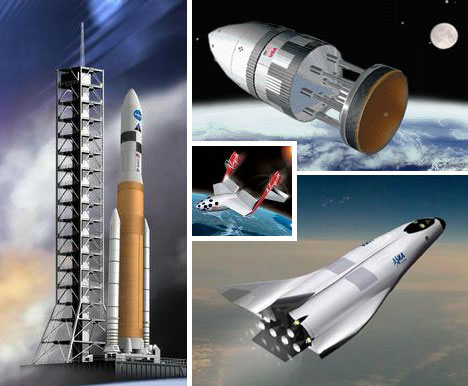
When it comes to space flight, the sky’s no limit. Long one of humanity’s ultimate goals, breaking the surly bonds of Earth takes a lot of thought – it IS rocket science, after all – and any number of big ideas have been hashed & trashed along the way to the future. Here are 15 of the biggest, weirdest and yes, coolest.
Project Orion
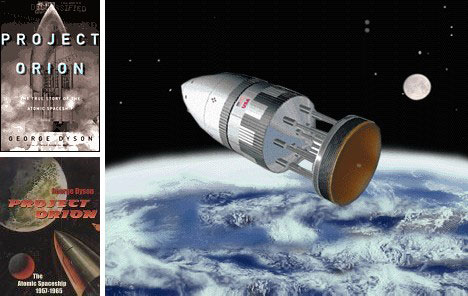 (image via: Stars2)
(image via: Stars2)
Project Orion was a product of the Atomic Age, a time when the power of the atom was seen as the solution to any number of problems. Though the thought of a spaceship propelled by a series of nuclear explosions seems nightmarish (especially for the astronauts), Project Orion reached an advanced level before reason prevailed. Here’s a video of what a voyage on an Orion ship would look like:
Early concepts foresaw nuclear power being used to launch the rocket; the version shown in the video has the bombs not being used until the craft escaped the atmosphere. Of course, it would still be carrying dozens of nuclear charges on board, making every launch a nail-biting event.
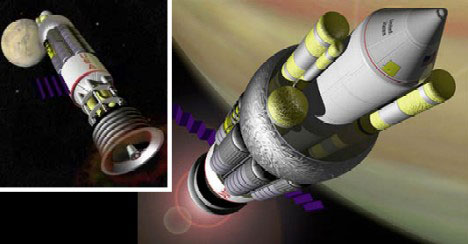 (image via: Wikimedia)
(image via: Wikimedia)
Originally conceived in the late 1950s at the height of the Cold War, the master plan for Project Orion called for a 4,000 ton spacecraft making trips to Mars in 1965 and Saturn by 1970.
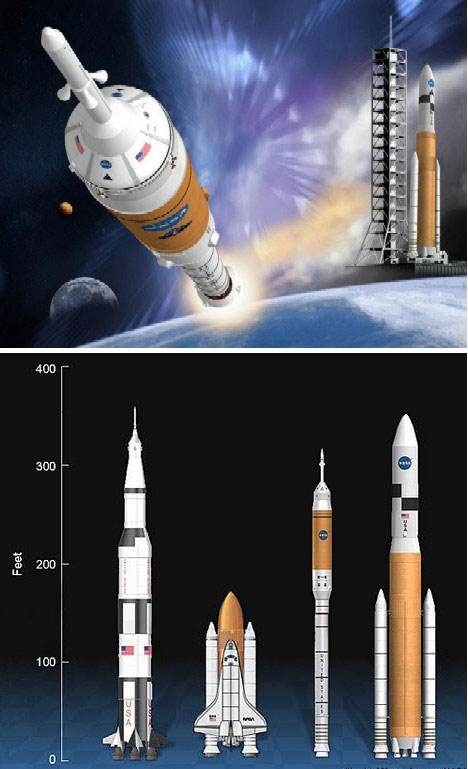 (image via: Nigel Worrall and Project Orion)
(image via: Nigel Worrall and Project Orion)
Today, Project Orion has been revived… though thankfully sans nukes. The name refers to NASA’s renewed push to send astronauts to the Moon and Mars using a new generation of conventionally-powered rockets and spacecraft.
200,000 Chinese Engineers
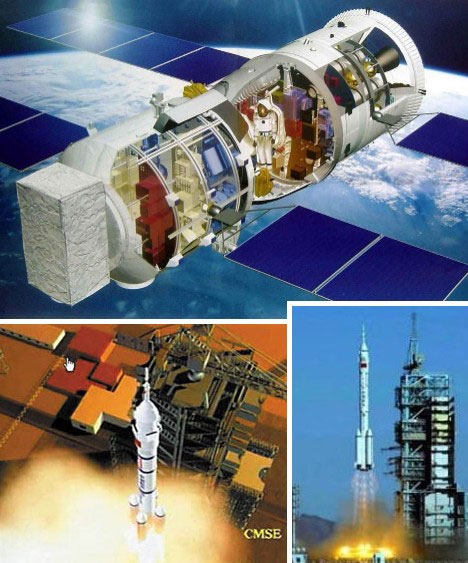 (image via: DefenceTalk.com)
(image via: DefenceTalk.com)
While NASA’s Project Orion is America’s prime venture; China has grand plans of her own. Approximately 200,000 engineers and scientists have hoisted the Middle Kingdom into the space race. If the above images of the newest Shenzhou-class vehicles are any indication, much more than the East may be red in the coming years.
South Korea: 2020 and Beyond
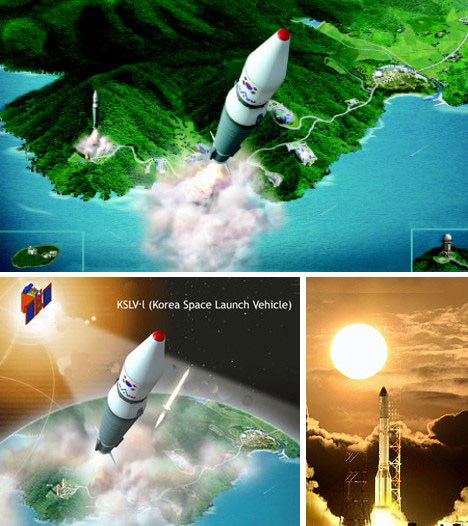 (image via: Spaceports)
(image via: Spaceports)
South Korea also has an ambitious space program. Planning is at an advanced stage for the nation’s first moon shot in 2020. South Korea has constructed their Naro Spaceflight Center in the southern part of the country, far from Kim Jong-Il’s prying eyes.
Japan’s $26 Billion Dream
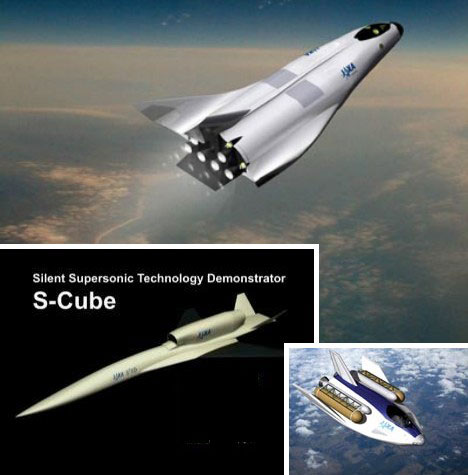 (image via: How Stuff Works)
(image via: How Stuff Works)
Japan’s space agency (JAXA), goaded onward by those of its neighbors, has shown off some very advanced concepts that have immense potential – with matching price tags. The Earth-Moon manned transport shown above is estimated to cost upwards of $26 billion by the time it’s completed in the mid 2020s.
India Reaches for the Stars
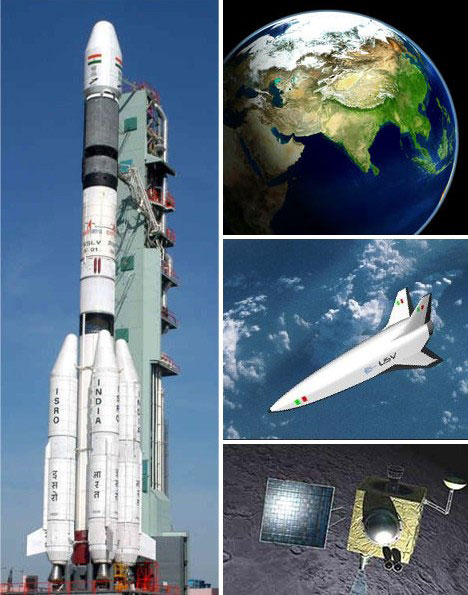 (image via: Spaceports)
(image via: Spaceports)
Even India has gotten into the game. The country is flush with highly-educated young engineers who have devoted themselves to the Indian Space Research Organization (ISRO) India’s space agency. The GSLV Mark III rocket shown above-left will be ready to launch astronauts into orbit by 2014. With a bigger budget than NASA and almost as many employees, India is sure to build upon its recent successful Lunar orbiter, Chandrayaan-1.
The Russian Kliper
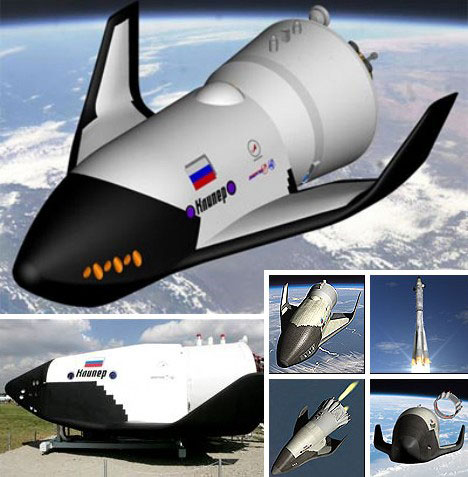 (image via: The Space Review)
(image via: The Space Review)
Russia was the first nation to loft both a satellite and a human being into orbit, and the original spacefarers aren’t done yet. Petrodollars have reflated the country’s economy and with it, its space program. The chunky ship above may not look like a clipper but that’s its name: Kliper. The six-passenger module will work much like the soon-to-be-retired space shuttle as it is launched into orbit on top of a massive Proton rocket.
Virgin Galactica Spaceship Two
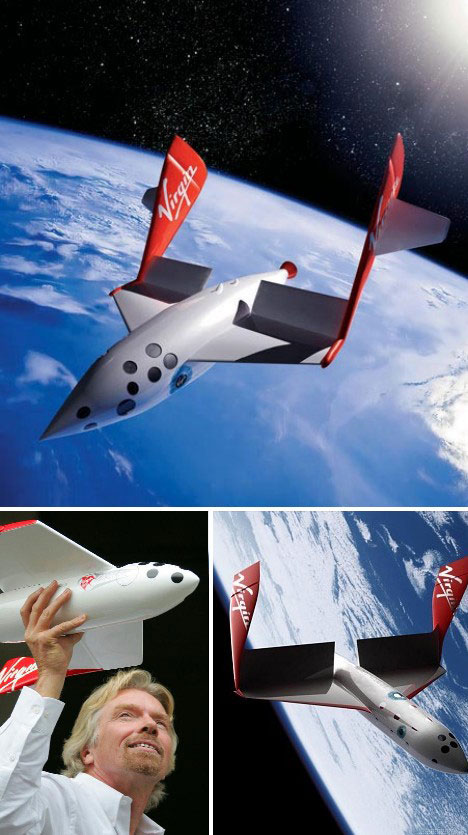 (image via: The Daily Tamasha)
(image via: The Daily Tamasha)
Let’s not forget the private sector, led by Virgin Galactic with its spectacular Spaceship Two. Behind the sci-fi moniker are the hard-charging personality of founder Richard Branson and some of the best space techies on the planet.
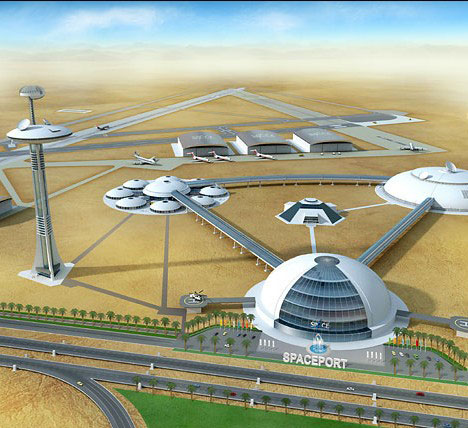 (image via: Tropolism)
(image via: Tropolism)
Virgin Galactic also plans on establishing the world’s first privately owned & operated spaceport, an artist’s rendering of which is shown above.
Heavy Lifting
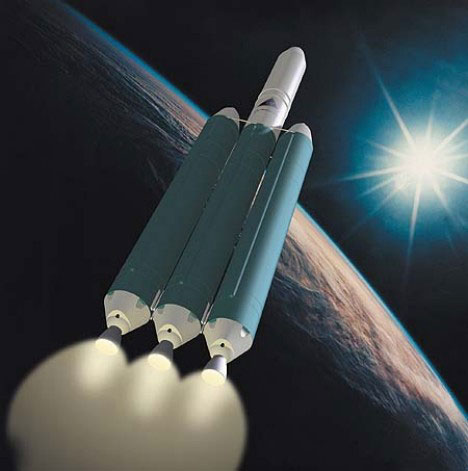 (image via: Space Today)
(image via: Space Today)
All well and good, but chemically fueled rockets have their drawbacks, notably the heavy mass of propellant that must be lifted into weightlessness. Even new heavy lift rockets like the Boeing Delta 4 shown above and the competing Lockheed-Martin Atlas 5 can get crews and cargo into orbit, not beyond. The next generation of space vehicles will use a range of propulsive drives, many of which were predicted by science fiction writers of the last century.
NASA’s Plasma Motors
 (image via: Gizmodo and Pointniner.com)
(image via: Gizmodo and Pointniner.com)
One of these new technologies is plasma – often referred to as the fourth state of matter. Plasma is exceptionally hot and doesn’t like to be confined, making it an ideal thrust propellant. Its tendency to destroy any container it’s put into, on the other hand, requires a leap in tech know-how before it can be considered a practical, reliable space power source. NASA intends to test a prototype plasma motor at the ISS within just a couple of years.
Sailing the Starry Seas
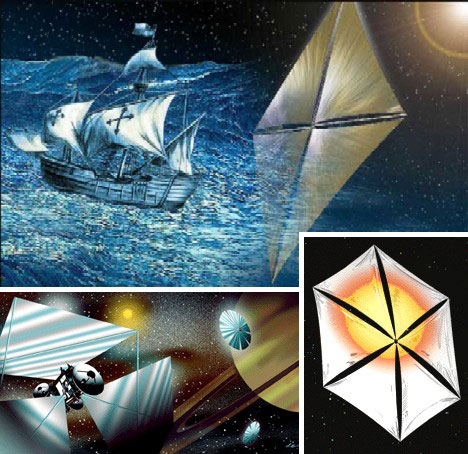 (image via: Laura Givens)
(image via: Laura Givens)
Solar sails have played key roles in works of science fiction but new technology has made the sails very, er, salable to spacefaring nations. A spacecraft employing a solar sail rides on the wind – the solar wind. It may not be fast but it IS cheap. Solar sails can also be given a boost from laser stations on Earth (or any other convenient planet or moon).
Robert’s Ramjet
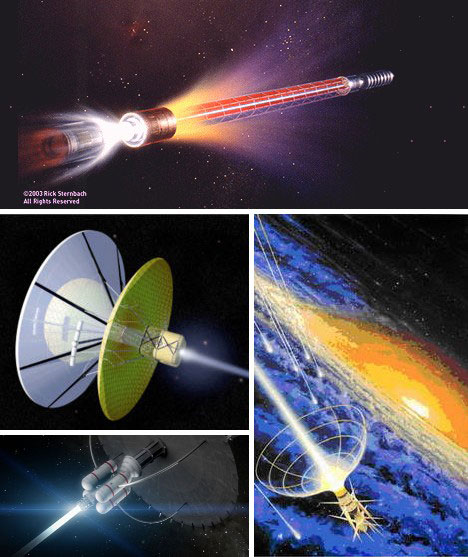 (image via: Space Media and This Is Rocket Science)
(image via: Space Media and This Is Rocket Science)
Dr. Robert Bussard sadly passed away in 2007 but he’ll be remembered for his radical theory of interstellar space propulsion, the eponymous Bussard Ramjet. This innovative rocket engine answers one of the great stumbling blocks to ultra-long-distance travel: what to use for fuel? Using powerful magnetic fields, the rocket motor acts as a scoop that collects and compresses far-flung molecules of hydrogen in deep space. Theoretically the ramjet has unlimited range and infinite speed.
Return to the Moon
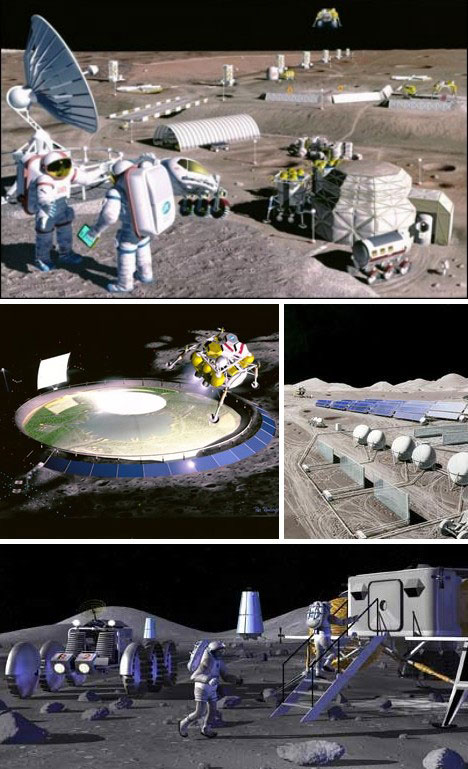 (image via: Kipr.org )
(image via: Kipr.org )
With Bussard Ramjets, humanity can spread itself across the galaxy and perhaps, even beyond. Long before our species hits its full stride, however, we must take baby steps – to the Moon, Mars, then the moons of Jupiter and Saturn. What will those pioneering settlements be like? Above are some views of a future lunar colony, possibly at one of the poles where water ice may be found.
 (image via: NASA )
(image via: NASA )
“The moon is a harsh mistress” but the accommodations appear very inviting! They would have to be – homesickness isn’t an option when home is several hundred thousand miles away.
Mars: The Future is Red
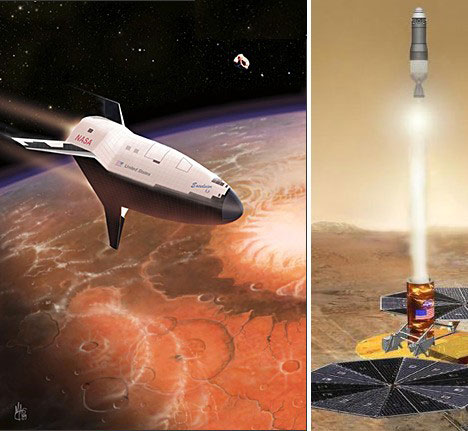 (image via: Space-Art )
(image via: Space-Art )
Mars is next on the horizon and the ships that carry the first human explorers will be bigger, more powerful and more costly to build than anything yet designed. Small sample-return missions (above right) will help mission planners back on Earth pinpoint optimum landing sites, possibly in regions of the Red Planet where water ice has been found inches underground.
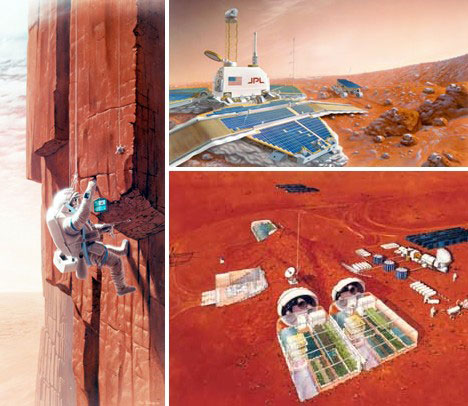 (image via: LPI-USRA )
(image via: LPI-USRA )
Pathfinding missions will be followed by full-fledged landings leading to the establishment of permanent colonies. Settlers will have to depend on supplies from Earth at first but if the Martian soil is as fertile as NASA’s robotic explorers tell us, greenhouses will shelter plants grown for food.
 (image via: Space-Art )
(image via: Space-Art )
After Mars? The solar system is a big pace and the nearest star is just a little over 4 light years away. Hibernation or multi-generational star ships may be required to travel great distances, or will technology provide another way? Time will tell… until then, we can only dream.